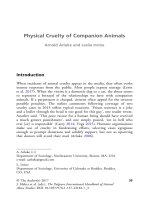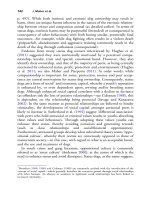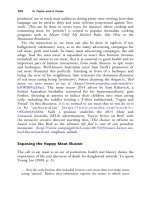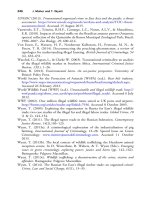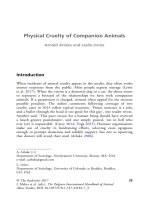The palgrave international handbook of a 54
Bạn đang xem bản rút gọn của tài liệu. Xem và tải ngay bản đầy đủ của tài liệu tại đây (39.81 KB, 1 trang )
42
A. Arluke and L. Irvine
think of his actions (Favre 2009). Some methods of dog training include
physical ‘corrections’, such as jerking, shocking and hanging or swinging
the dog by a leash. Critics of these methods consider them cruel (Owens
and Eckroate 2007). Concerned citizens who report the use of such
methods have found that cruelty laws provide exemptions for training,
and courts have ruled that ‘a beating inflicted for corrective or disciplinary
purposes without an evil motive is not a crime, even if painful and
excessive’ (State v. Fowler, 205 S.E.2d 749, N.C. Ct. App. 1974). Laws
also provide exceptions for hunting and farming. Practices considered
acceptable and necessary in agriculture, such as branding, castration and
beak trimming, all done without anaesthetics or analgesics, would be
considered inhumane and illegal if performed on a companion animal.
The infliction of pain, even to the point of suffering, does not necessarily
constitute cruelty. Thus, the nature of cruelty is situational, and the same
treatment ‘in one context can be regarded as cruel, while in another it can
be considered culturally acceptable’ (Arluke 2006, p. 184).
Some attempts to assess the nature of cruelty emphasise motive, specifying it as ‘the wilful infliction of harm, injury, and intended pain’ (Kellert
and Felthous 1985, p. 1114), ‘behavior that intentionally causes unnecessary pain, suffering, or distress’ (Ascione 1993, p. 28), or the ‘desire to gain
satisfaction from the infliction of suffering, pain, or some other harm’
(Rowan 1999, p. 330). Yet, sadism does not characterise all perpetrators of
cruel acts. As Regan argues, ‘some cruel people do not feel pleasure in
making others suffer. Indeed, they seem not to feel anything’ (1980,
p. 534). Insensitivity to suffering, rather than sadistic enjoyment of it,
can also count as cruelty. Consequently, many statutes include not only
intention but also ‘reckless indifference’ to an animal’s pain (Garner 2014,
p. 303). Cruelty might result from ignorance, carelessness or neglect;
indeed, these constitute the primary sources of suffering among companion animals (Patronek 1997; Solot 1997). Although some argue that the
lack of ‘deliberate maliciousness’ makes the resulting abuse less serious
(Rowan 1993, p. 218), statutes often use the term ‘cruelty’ ‘generically to
encompass both deliberate infliction of harm and harm that arises from
neglect’ (Patronek 1997, p. 277; see also Donley et al. 1999).
In sum, numerous challenges arise when attempting to characterise the
nature of cruelty. Limiting the discussion to companion animals overlooks
the suffering endured by the majority of animals, such as those involved in
food production, through practices considered acceptable and legal.
Determinations of cruelty depend not just on statutory language but also
on context, situation, purported ‘necessity’, intention and motive.
